In our last post, Top 101 Persian Proverbs & Their English Equivalents Explained, we explored a variety of Persian proverbs and their English counterparts, delving into the wisdom embedded in these age-old sayings. One proverb that stands out for its deep and illustrative story is «کار نیکو کردن از پر کردن است» “Kāre niku kardan az por kardan ast” which translates to “Practice makes perfect.” This proverb encapsulates the idea that mastery and skill come through consistent effort and perseverance. This timeless adage underscores the importance of perseverance and consistent effort in mastering any skill.
Today, we will unravel the intriguing tale behind this proverb, focusing on the story of Bahram Gur, a legendary Sassanian king, and his interactions with a significant female figure (Azade in the Shahnameh, which was renamed Fetne in Nizami’s Haft Peykar). Through their stories, we gain a deeper understanding of how the proverb reflects the values and lessons of Persian literature and history. Nizami’s account not only highlight Bahram’s prowess and character but also shed light on how practice and repetition can lead to mastery, a concept that has echoed through Persian literature and art for centuries.

Main Figures
Who is Bahram Gur?
Bahram V, also known as Bahram Gur, was a Sassanian King who reigned from 420 to 438 AD. His nickname “Gur,” meaning “onager” or wild ass, reflects his reputation as a skilled hunter. Born to Yazdegerd I, Bahram was sent to the Lakhmid court in al-Hira at an early age, where he was raised under the guidance of the Lakhmid kings. His return to the Sassanian capital of Ctesiphon was marked by a legendary trial where he won the throne by demonstrating his bravery against two lions.
Bahram’s reign is remembered as a period of prosperity, and his life has been immortalized in numerous Persian literary works, including Ferdowsi’s Shahnameh and Nizami’s Haft Peykar. His stories, filled with romance, adventure, and moral lessons, have made him a central figure in Persian cultural heritage.
Who is Azade?
Azade (Pronounced Āzāde), or Azadvar, was the most prominent female musician of the Sassanian period. The tale of her love with Bahram Gur became so famous that it was recounted for centuries, inspiring Iranian artists to use it as a theme in their paintings, illuminations, and carvings. Azade’s character is so notable that, besides Ferdowsi, both Nizami in the Haft Peykar and Amir Khusrow Dehlawi in Hasht Behesht have also explored her story. Even historians like Ibn Faqih Hamedani, Mutahhar ibn Tahir al-Muqaddasi, Abu Mansur Tha’alibi, and many others have referred to it.
The Story in Shahnameh: Bahram Gur and Azade
According to the Shahnameh, Bahram’s love for Azade was so profound that he constantly spoke her name. In the only recorded instance in history, Bahram trusted Azade so much that he would go hunting with her alone, without his troops, even though Azade was nothing more than a slave girl. He would seat her on his horse behind him. One day, during one of these hunts, Bahram saw a pair of gazelles and asked Azade how he should hunt them. Azade, who loved animals, told Bahram that real men don’t fight with gazelles:
چنین گفت آزاده ک«ای شیرمرد / به آهو نجویند مردان نبرد!»
Such a remark from a slave girl to a king is unprecedented in the Shahnameh and demonstrates Azade’s courage and independence in the face of the king of Iran. Historically, it’s important to note that in that era, a slave girl speaking to a king in such a manner could have led to her death.
Realizing that Bahram would not change his mind, Azade devised a plan to save the gazelles by giving Bahram an impossible task. She suggested that he first turn the female gazelle into a male and the male gazelle into a female. Then, when the gazelle flees, he should shoot an arrow through its ear. After that, when the gazelle scratches its ear with its hoof, he should shoot another arrow so that the gazelle’s head, leg, and ear are sewn together! But to her amazement, Bahram, known for his hunting skills, accomplished this easily, and the gazelles died painfully. According to the Bombay lithograph edition, Azade then told Bahram Gur that only a demon could kill animals in this way:
کنیزک به او گفت: «اهریمنی! / وگرنی بدینسان کجا افکنی؟!»
The Dar al-Kutub edition in Cairo also notes that after the gazelles died, “Azade shed tears like a river” and rebuked Bahram:
She told the king: “This is not manliness; your manhood is madness!”
ابا شاه گفت: «این نه مردانگیست / ز مردی تو را خوی، دیوانگیست!»
It’s important to remember that Azade was merely a slave girl, while Bahram V was the king of one of the greatest empires in Sassanian history and one of the world’s greatest kings of his time! But as Ferdowsi says:
“Whoever seeks the reins of greatness, must first renounce himself.”
عنانِ بزرگی هر آنکس که جُست، / نَخُستین بباید ز خود دست شُست
As a result of this exchange, Bahram trampled Azade to death under his horse’s hooves.
The Story in Haft Peykar: Bahram Gur and Fetne
One day, Bahram Gur, the Sassanian king, went hunting with his beautiful Chinese slave girl named Fetne. He successfully hunted many wild ass, and while all the king’s companions praised Bahram’s skill and mastery in hunting, Fetne remained silent and offered no words of admiration for the Sassanian ruler.
After a while, Bahram noticed a wild ass in the distance and said to Fetne, “I would like to hunt this onager in any way you desire.” With a hint of arrogance, Fetne requested that he pin the onager’s foot to its head with an arrow:
“You must ignite your face with fervor / And sew this onager’s head to its hoof.”
گفت: «باید که رخ برافروزی / سر این گور در سمش دوزی»
Bahram skillfully placed a stone in his sling and shot it with precision so that it landed in the onager’s ear. The poor animal, trying to scratch its ear, lifted its right hoof close to its head. At that moment, Bahram shot another arrow, pinning the onager’s foot to its head.
Fetne said, “If a person practices and perseveres in any task, they will certainly become skilled, as ‘Practice makes perfect.'”
گفت پُر کرده شهریار این کار/ کار پُر کرده کی بود دشوار؟!
هرچه تعلیم کرده باشد مرد / گرچه دشوار شد بشاید کرد
رفتن تیر شاه بر سم گور / هست از ادمان نه از زیادتِ زور
Hearing this, the king became angry and harbored resentment toward her. He then ordered a nobleman in his service to execute the audacious and insolent girl.
When Fetne realized she was facing death, she pleaded with the nobleman, asking him not to act hastily in carrying out the king’s command. She said, “The king might one day regret his order, and if you execute it without hesitation, you may incur his wrath and displeasure. If you exercise caution and spare my life, I promise to find a way to ensure that Bahram Gur not only refrains from being angry but also bestows even greater favor and kindness upon you.”
The nobleman, persuaded by her words, decided to hide her in a towering palace outside the city, where she could live in secrecy and work as one of the servants, concealing her identity.
During her early days at the palace, a calf was born, and Fetne occupied herself with it. The nobleman’s lofty palace had sixty steps, and Fetne would carry the newborn calf on her shoulders, climbing up and down the palace steps several times a day. As the days and nights passed, the calf grew larger and stronger, but since she carried it daily, the gradual increase in weight was manageable for her. Eventually, the calf grew into a heavy bull, yet Fetne, with her slender and frail frame, continued to carry the bull on her shoulders, climbing the sixty steps up to the top of the palace and back down again.
Finally, one day, Fetne saw the opportunity and asked the nobleman to bring Bahram Gur to the sixty-step palace garden. The nobleman did as she requested and, on a day when Bahram was out hunting onagers, invited him to rest and relax in his beautiful garden and palace. The Sassanian king, unable to endure climbing all those steps, said to the nobleman, “How do you expect to navigate such a palace in your old age?”
The nobleman seized the moment and recounted the story of a slender, frail girl who daily carried a massive bull on her shoulders, climbing the sixty steps to the top of the palace.
The Sassanian king was intrigued and expressed his desire to witness this feat. He asked the nobleman to bring the girl and have her carry the bull up to the top of the palace.
Fetne, with her face covered, astonished Bahram Gur and his companions by lifting the bull onto her shoulders and, without a trace of fatigue or complaint, carrying it step by step to the top of the palace. After setting the bull down, she turned to the king and said, “Who in this world can carry this massive bull on their shoulders and bring it down the palace steps?”
Bahram, hiding his surprise, said, “I know how you accomplished this remarkable feat. You started carrying this bull when it was a newborn calf and, through consistent practice and perseverance, the growth of the calf did not hinder your determination or ability. You yourself know well that this is not due to strength but the result of instruction, practice, and perseverance because ‘Practice makes perfect.'”
The beautiful slave girl, who had been waiting for such a question and reasoning, responded without hesitation and with a touch of irony: “Your Majesty, if a weak woman can carry a bull to the top of a sixty-step palace, it is not surprising and should be attributed to practice and perseverance. But if the king can pin a onager’s hoof to its ear, should that not also be considered a result of training and practice?”
Bahram Gur quickly realized that this was the same beautiful slave girl from China. He then requested that she unveil her face, and when her identity was revealed, Bahram stood beside her and apologized for what had happened. He also praised and rewarded the nobleman for not hastily carrying out the execution and for keeping the girl alive.
This version of the story emphasizes the importance of perseverance and gradual improvement, aligning perfectly with the proverb’s message.
The Story of Bahram and Azade/Fetne in Iranian Art
Many of the motifs found on the surfaces of vessels and other historical-cultural objects within museums cannot be considered merely simple decorative designs. Rather, many of them are imbued with literature and a history rich in allure and incident.
Understanding this background is of great importance to all those interested in museums and the cultural heritage of the past, especially for experts and museum professionals working in these institutions. Undoubtedly, the selection and repetition of certain motifs on various objects by artists of different periods could never be a matter of mere coincidence or simple imitation. The continuation of a motif requires a rich cultural foundation, enabling it to survive beyond political upheavals and remain resilient through cultural and social changes, thereby ensuring its visual life for centuries, and at times, even millennia.
The story of Bahram and Azade, or Fetne, has been a popular motif in Iranian art for centuries. Sassanian silver plates, Islamic-era bowls, and enameled vessels often depict scenes from these tales, showcasing the enduring impact of these narratives on Persian culture.
One such Sassanian silver plate, housed in the Hermitage Museum, illustrates Bahram and Azade on a camel, with Bahram poised to shoot at gazelles while Azade plays the harp. This scene captures the tension and drama of their relationship, as well as Bahram’s prowess as a hunter.
Another depiction can be found on a 6th-century enameled bowl from the Reza Abbasi Museum in Tehran. This artwork also portrays the hunting scene, further cementing the story’s place in the visual culture of the time.
These artistic representations not only preserve the stories of Bahram and Azade/Fetne but also reflect the broader themes of love, power, and the consequences of pride that resonate throughout Persian literature.
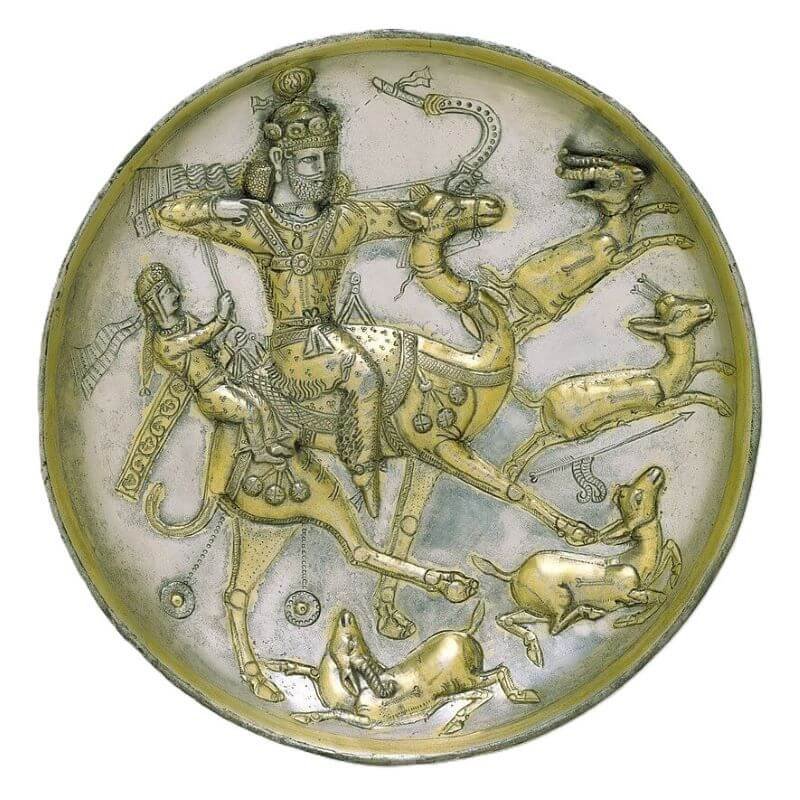
Plate with a hunting scene from the tale of Bahram Gur and Azadeh
Sasanian, ca. 5th century CE
The Metropolitan Museum of Art
This plate was likely hammered into shape and then decorated to highlight its varied surface contours and colors, making its human and animal forms stand out in relief. It was partially gilded using a mixture of mercury and gold, which could be painted onto the surface.
Bahram Gur and Azada
12th–13th century
The Metropolitan Museum of Art
Some of the mina’i ceramics illustrate stories from the Persian epic, the Shahnama, predating its earliest surviving illustrated manuscripts by nearly a century. This bowl depicts the episode of Prince Bahram Gur hunting with Azada, his favorite concubine. Azada challenges Bahram Gur to a hunting feat, but when he succeeds, she pities the slain gazelles and reproaches him. In anger, he tramples her under his camel’s feet. The painter has conflated two different moments into one scene.
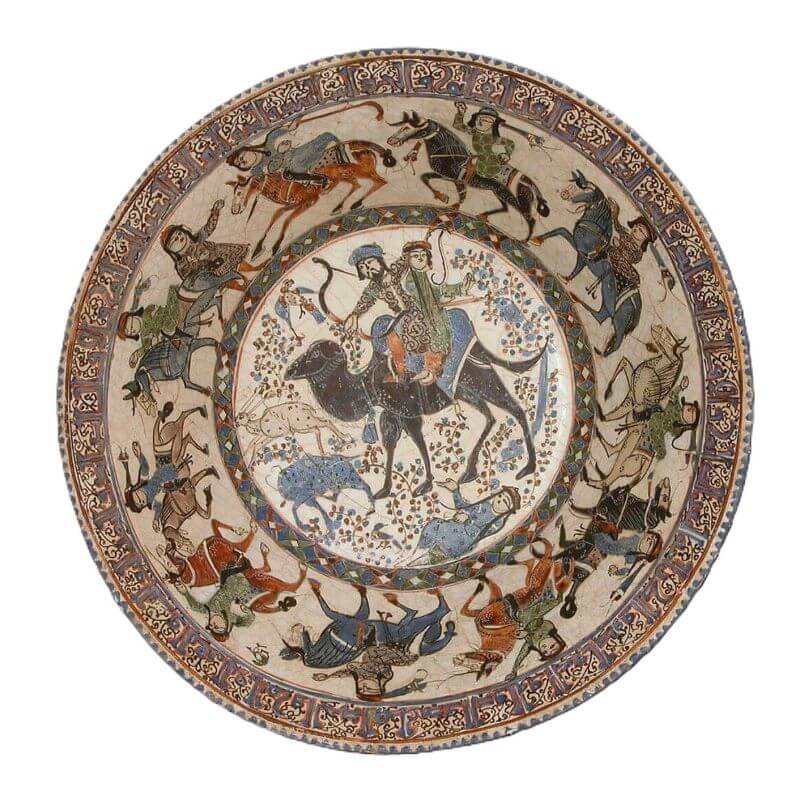
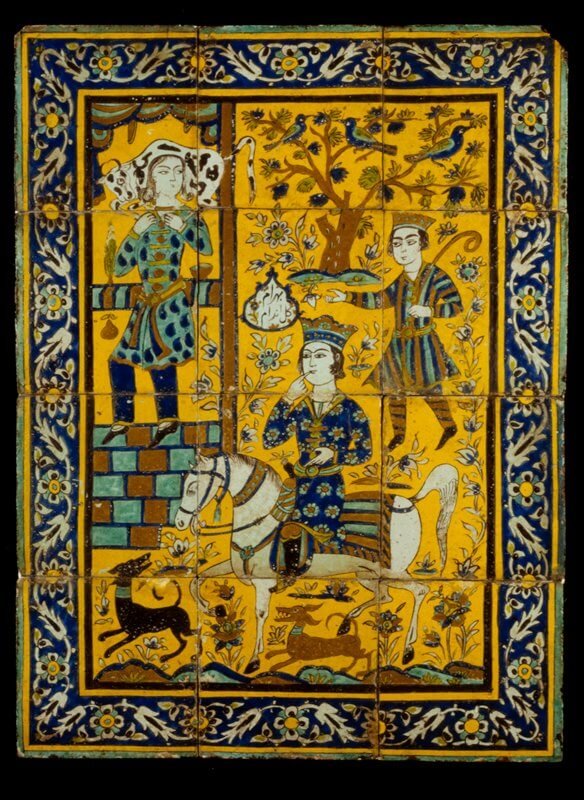
Tile painting depicting Bahram Gur and Fetne (“Practice Makes Perfect”),
c. 1625-50
Khamsah Shah Tahmasb’s copy
Painting by Muhammad Zaman dated Mazandaran, 1086 (1675/76)
The servant girl Fitnah impresses Bahram Gur with her strength by carrying an ox on her shoulders.
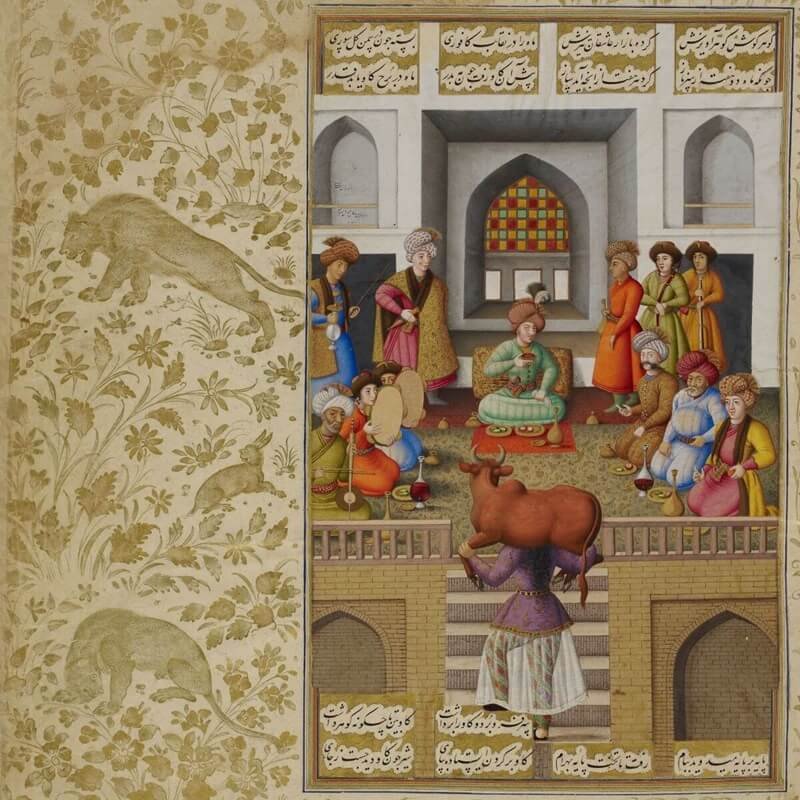
![Coffeehouse Painting (Contemporary Period, by Hossein Qollar Aghasi)
In this artwork, the lower part of the painting depicts Bahrame Gur (Bahram the onager [hunter]) and Azade sitting on a camel and playing the harp. In the upper part of the painting, Azade (known as Fetna) is shown with a calf mounted on her back, descending the stairs of a building.](https://joyofpersian.com/wp-content/uploads/2024/08/nezami-5ganj-7peykar-sh20-FI.jpg)
Coffeehouse Painting
Contemporary Period, by Hossein Qollar Aghasi
In this artwork, the lower part of the painting depicts Azade (aka Fetne / Golandam) sitting on a camel and playing the harp.
In the upper part of the painting, Azade is shown with a calf mounted on her back, descending the stairs of a building.
Bahram Gur’s Hunting Ground
Place and Date of Weaving: Kashan, 19th Century CE
Location: Carpet Museum of Iran
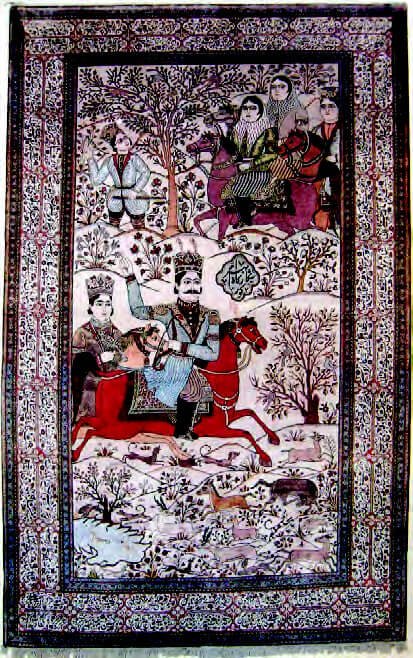
Conclusion
The proverb “Kāre niku kardan az por kardan ast” encapsulates a fundamental truth about human endeavor: mastery comes through practice and perseverance. The stories of Bahram Gur, as recounted in the Shahnameh and Haft Peykar, illustrate this principle in vivid detail. Whether through the tragic tale of Azade or the cunning survival of Fetne, these narratives remind us of the importance of consistent effort in achieving greatness.
Moreover, the legacy of these stories in Iranian art demonstrates how deeply ingrained these cultural values are in Persian history. As we reflect on these ancient tales, we are reminded that the pursuit of excellence is a timeless endeavor, one that transcends the boundaries of time, culture, and art.
If you enjoyed learning about Bahram Gur and the rich cultural heritage behind this Persian proverb, share this story on your favorite social networks! Let others discover the timeless wisdom in these tales and join the conversation.
Every culture has its own proverbs and stories that offer timeless wisdom. Do you have a favorite proverb or tale from your own heritage that reflects themes similar to this story? We’d love to hear it! Share your insights and stories in the comments below, and let’s explore the diverse world of cultural wisdom together.
References
یک داستان و چهار روایت مقایسه داستان بهرام گور در شکارگاه در چهار منظومه
آزاده، پهلوانبانوی موسیقی ایران
داستان آزاده و بهرام در هنر ایرانی
بررسی روایت تصویری از نقشآفرینی “آزاده” در داستان بهرام گور
بررسی ادبیات غنایی در فرش های تصویری دوره قاجار (مطالعه موردی: داستان های بهرام گور)
Bahram Gur and Fetne (Feminist Folktales 12.) => Milo of Croton(Britannica): According to legend, Milo trained by carrying a calf daily from its birth until it became a full-sized ox.
